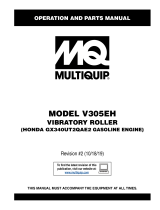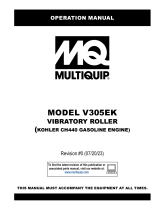
PAGE 12 — AR14H RIDE-ON ROLLER • OPERATION MANUAL — REV. #4 (09/08/20)
GENERAL INFORMATION
The AR14H roller has been designed for asphalt application
and compaction of granular soils used in site preparation.
Machine should only be used for the purpose intended and
by experienced personnel who understand this operation
manual and all safety decals. Typical applications for this
roller are compaction of base material, asphalt patching
and roadway construction.
Standard features included with this roller are compact
design, recessed drive motors,maintenance-free articulation
joint and vibrator assembly, easy-to-use controls, 34-gallon
(130 liters) water tank, and hour/tachometer.
POWER PLANT
The AR14H roller is powered by a Honda GX630, air-
cooled, gasoline engine rated at 20.8 hp @3,600 rpm.
The engine features a side-mounted muffler designed to
direct engine exhaust away from the operator. In the event
of low oil, this engine has a built in "oil alert system" that
will shut down if the engine oil level reaches an unsafe
operating level.
HYDRAULIC SYSTEM
The Honda GX630 engine drives an axial hydraulics,
variable displacement pump which is manually controlled
via a cable control system. Pump flow is directed through
an aluminum block manifold which provides the control for
the 3 hydraulic motors.
The hydraulic drum drive system incorporates a series
closed loop configuration operating at a maximum pressure
of 2,900 psi. In addition this hydraulic system offers a "free
wheel valve" which allows the roller to be towed in the event
of an emergency.
The forward-reverse control lever operates the hydrostatic
pump which governs the roller speed and direction of
travel. The speed in which movement of this lever is made
is directly related to the amount of pressure that is applied
to the travel lever in each direction. Travel speed is infinitely
variable from 0 to 4.8 mph. The neutral position of this lever
will cause the roller to stop.
COMPACTION SYSTEM
The compaction force is delivered by a 35.6-inch wide steel
drum with beveled edges to help prevent asphalt marring.
A fully enclosed hydraulic drive system offers a variable
speed control as well as smooth acceleration and braking.
Connected to the axial hydraulic pump is a gear pump
that provides power for the drum vibratory system and the
articulating steering system. Oil from this pump flows to the
manifold control valve block and then to a hydraulic motor
which rotates the eccentric weights inside a sealed housing
containing grease to lubricate the bearings.
A toggle switch located on the side of the travel lever,
activates a valve that engages or disengages the vibratory
action. The drum's vibratory action generates 3,400 lbf
(15.1 kN) of centrifugal force at a frequency of 4,200 vpm
(vibrations per minute). If the vibration appears to be weak
or slow, allow the machine to warm up thoroughly, and
check the hydraulic oil level. Add hydraulic oil if necessary.
The vibrator housing and drum are shock mounted to
isolate the engine compartment and operator from vibration.
The roller nominally has an operating weight of 2,688 lb.
(1,219 Kg) but can be increased to 2,980 lb. (1,352 Kg) by
adding a water ballast to the rear drum.
HYDRAULIC OIL FILTER SYSTEM
The hydraulic system oil is filtered by a screen type filter
located in the reservoir filler neck, then doubled filtered
within the system first by a 40 micron mesh-type suction
filter located in the tank and the by a Zinga 10-micron,
cartridge style, spin-on return line filter.
ARTICULATED STEERING SYSTEM
Power for the articulated steering system, which uses a
single hydraulic cylinder, is provided by the gear pump.
This steering system can produce an inside turning radius
of 150 inches (3.81 meters).
SPRINKLER SYSTEM
A 34-gallon (130 liters) water tank, with a pressurized
feed spray bar, is provided for wetting the roller for asphalt
pavement rolling.
The water system is fully adjustable from the operator’s
position with a single volume control.
LIFTING THE ROLLER
When lifting of the roller is required, attach a
suitable hook or shackle to the lifting eyes of the
roller. These four lifting points are marked by a
lifting hook decal. Make sure the lifting device
is capable of lifting 4,000 lb. (1,814 Kg).




























